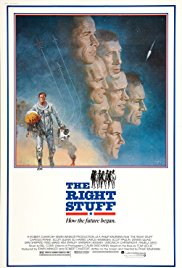Tom Wolfe, in his book The Right Stuff, contends that the astronauts became a modern equivalent of the “champions” of early human warfare. The Soviet success in putting satellites into orbit had shattered the assumption that the U.S. had superior technology that would protect it from Russian armaments. By 1959, not only did the Russians have the atomic bomb, but it looked as if they would soon control space and be able to deliver those bombs from this new high ground. It was frequently said and fervently believed that if the Russians won the “space race” the United States was doomed. Wolfe writes, at pages 122 and 123 that in this context, the U.S. and Russian manned space flight programs:
… [Brought] back to life one of the ancient superstitions of warfare. Single combat had been common throughout the world in the pre-Christian era and endured in some places through the Middle Ages. In single combat the mightiest soldier of one army would fight the mightiest soldier of the other army as a substitute for a pitched battle between the entire forces. In some cases the combat would pit small teams of warriors against one another. Single combat was not seen as a humanitarian substitute for wholesale slaughter until late in its history. That was a Christian reinterpretation of the practice. Originally it had a magical meaning. In ancient China, first the champion warriors would fight to the death as a “testing of fate,” and then the entire armies would fight, emboldened or demoralized by the outcome of the single combat. Before Mohammed’s first battle as the warrior-prophet, the Battle of Badr, three of Mohammed’s men challenged the Meccans to pick out any three of their soldiers to fight in single combat, proceeded to destroy them with all due ceremony, whereupon Mohammed’s entire force routed the entire Meccan force. In other cases, however, the single combat settled the affair, and there was no full-scale battle, as when the Vandal and Aleman Armies confronted each other in Spain in the fifth century C.E. They believed that the gods determined the outcome of single combat; therefore, it was useless for the losing side to engage in a full-scale battle. The Old Testament story of David and Goliath is precisely that: a story of single combat that demoralizes the losing side. The gigantic Goliath, with his brass helmet, coat of mail, and ornate greaves, is described as the Philistine “champion” who comes forth to challenge the Israelites to send forth a man to fight him; the proposition being that whoever loses, his people will become the slaves of the other side. Before going out to meet Goliath, David — an unknown volunteer — is given King Saul’s own decorative armor, although he declines to wear it. When he kills Goliath, the Philistines regard this as such a terrible sign that they flee and are pursued and slaughtered. Mr. Wolfe notes that the public adored the astronauts, once they actually made it into space. Through their skill and willingness to risk their lives, they were the men who would protect the nation and redeem our national honor. See for example, Wolfe’s description of the ticker tape parade in Manhattan for John Glenn after the first U.S. orbital flight. While Glenn’s flight didn’t bring us close to the Russians in the space race, it gave us our first hope that we had a chance against the Russians.
People were crying, right out in the open, as soon as they laid eyes on John, … [T]here were people hanging over the railings … and they were crying and waiving little flags and pouring their hearts out.” … It was cold as hell, seventeen degrees, but the streets were mobbed. There must have been millions of people out there, packed from the curbings clear back to the storefronts, and there were people hanging out of all the windows, particularly along lower Broadway, where the buildings were older and they could open the windows, and they were filling the air with shreds of paper, every piece of paper they could get their hands on. …
Huge waves of emotion rolled over you. You couldn’t hear yourself talk, but there was nothing you could have said, anyway. All you could do was let these incredible waves roll over you. Out in the middle of the intersections were the policemen, … New York’s Finest, big tough-looking men in blue greatcoats — and they were crying! They were right out in the intersections in front of everybody, bawling away — tears streaming down their faces, saluting, then cupping their hands and yelling amazing things to John and the rest of [the astronauts] — “We love you, Johnny” — and then bawling some more, just letting it pour out. The New York cops!. . . pp. 347 & 348



